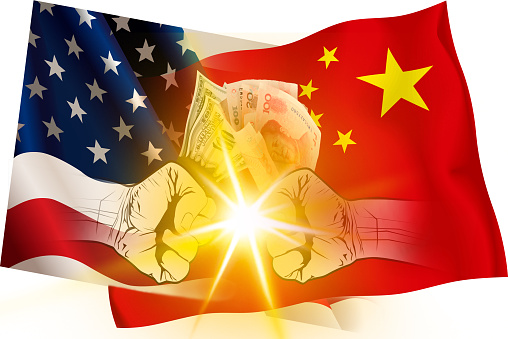Arizona’s Economic Relationship With China: Short-Term Benefits, Long-Term Risks
State governors usually seek to grow their states’ economies. One of Governor Ducey’s priorities has been to create a “21st Century Economy” in Arizona, which includes supporting “21st century companies that employ Arizonans.”[1] As part of his efforts to attract “21st Century companies” to the state, the Governor has actively sought to foster greater Chinese business and investment interest in Arizona.
In an interview with China Daily during the National Governors Association Summer Meeting in July 2017, Governor Ducey stressed that trade opportunities between China and Arizona included “public and private partnerships in our semiconductor, electronics, aerospace, defense industry, mining and ores.”[2] Four months later, ahead of President Trump’s visit to China, the Governor told China Daily, “We would love opportunities to sell more to China and other opportunities for investment. I think from the franchise business to the aerospace and defense business, we would like to do more business with China.”[3]
And there does appear to be some good news in the Arizona – China trade relationship. According to figures provided by the U.S. – China Business Council, the annual value of manufactured goods exports from Arizona to China has averaged about $1 billion per year since 2010. China is now Arizona’s third largest export customer (after Mexico and Canada). In 2019, Arizona exported $1.1 billion worth of manufactured goods to China (to include $385 million worth of semiconductors and components, $138 million in aerospace products and parts, and $71 million worth of navigational and measurement instruments). According to the Council’s 2020 report, “Arizona exports to China supported 14,700 American jobs in 2018,” although it did not specify how many of these jobs are in Arizona.[4]
But the news isn’t all good. A 2020 report by the Economic Policy Institute (EPI) found Arizona had experienced 65,800 net jobs displaced because of the U.S. – China goods trade deficit (2.28% of the state’s total estimated workforce) between 2013 and 2017. These job losses were spread across each of Arizona’s Congressional districts: [5]
|
CONGRESSIONAL DISTRICT
|
NUMBER OF JOBS DISPLACED |
| 1 | 3,900 |
| 2 | 3,800 |
| 3 | 5,400 |
| 4 | 4,500 |
| 5 | 14,200 |
| 6 | 7,900 |
| 7 | 7,200 |
| 8 | 7,300 |
| 9 | 11,600 |
| TOTAL | 65,800 |
Assuming Arizona – China trade does in fact support 14,700 jobs in Arizona, the EPI study suggests Arizona has actually lost an aggregate of 51,100 jobs due to the U.S.- China trade deficit – largely driven by Chinese predatory trade practices and unwillingness to abide by World Trade Organization (WTO) regulations.[6]
Chinese leaders probably do not share Governor Ducey’s vision of a “21st Century Economy” beneficial to the people of Arizona. China “does not seek to participate as an equal in the existing [international] order. Instead, it seeks to lead a China-centric order where China’s interests come first, and other countries are left to fight for what little is left.”[7] According to the Office of the Director of National Intelligence, “China will remain the top threat to United States technological competitiveness.”[8]
Much of this threat takes the form of economic espionage. According to the U.S. Department of Justice, about 80 percent of all economic espionage prosecutions allege conduct that would benefit the Chinese state, and there is at least some nexus to China in around 60 percent.
*****
[1] Office of the Governor, “21st Century Economy,” 21st Century Economy | Office of the Arizona Governor (azgovernor.gov), accessed May 10, 2021.
[2] Hong Xiao and Zhang Yu’an, “Arizona Looks to Sweeten China Ties,” China Daily, July 19, 2017, Arizona looks to sweeten China ties – USA – Chinadaily.com.cn, accessed May 10, 2021. The China Daily video of Governor Ducey’s interview is posted at ducey china daily global – Yahoo Video Search Results, accessed May 11, 2021.
[3] China Daily USA, “Governors Hail Strong Ties with China,” November 8, 2017, Governors hail strong ties with China – USA – Chinadaily.com.cn, accessed May 10, 2021.
[4] U.S. – China Business Council, 2020 State Export Report: Goods and Services Exports to China by US States to China Over the Past Decade, April 2020, 25, 2020 State Export Report (uschina.org), accessed May 10, 2021.
[5] Robert E. Scott and Zane Mokhiber, Growing Chinese Trade Deficit Cost 3.7 Million American Jobs Between 2001 and 2008 (Washington, DC: Economic Policy Institute, 2020), 58, Growing China trade deficit cost 3.7 million American jobs between 2001 and 2018: Jobs lost in every U.S. state and congressional district | Economic Policy Institute (epi.org), accessed May 10, 2021.
[6] Ibid., 1.
[7] Lieutenant Colonel John Schaus, Brian Evans, and Colonel Elizabeth Martin, A Changing Indo-Pacific Region: Growing Complexity for the Six Anchor Nations, Indo-Pacific Theater Design Working Paper 2 (Carlisle Barracks, PA: U.S. Army War College, September 2020), 3-4; A Changing Indo-Pacific Region: The Anchor Partners (armywarcollege.edu), accessed December 30, 2020.
[8] Office of the Director of National Intelligence, Annual Threat Assessment of the US Intelligence Community (Washington, DC: April 9, 2021), 7, ATA-2021-Unclassified-Report.pdf (dni.gov), accessed May 10,2021.
Additional References:
[1] Robert E. Scott and Zane Mokhiber, Growing Chinese Trade Deficit Cost 3.7 Million American Jobs Between 2001 and 2008 (Washington, DC: Economic Policy Institute, 2020), 58, Growing China trade deficit cost 3.7 million American jobs between 2001 and 2018: Jobs lost in every U.S. state and congressional district | Economic Policy Institute (epi.org), accessed May 10, 2021.
[1] Ibid., 1.
[1] Lieutenant Colonel John Schaus, Brian Evans, and Colonel Elizabeth Martin, A Changing Indo-Pacific Region: Growing Complexity for the Six Anchor Nations, Indo-Pacific Theater Design Working Paper 2 (Carlisle Barracks, PA: U.S. Army War College, September 2020), 3-4; A Changing Indo-Pacific Region: The Anchor Partners (armywarcollege.edu), accessed December 30, 2020.
[1] Office of the Director of National Intelligence, Annual Threat Assessment of the US Intelligence Community (Washington, DC: April 9, 2021), 7, ATA-2021-Unclassified-Report.pdf (dni.gov), accessed May 10,2021.




